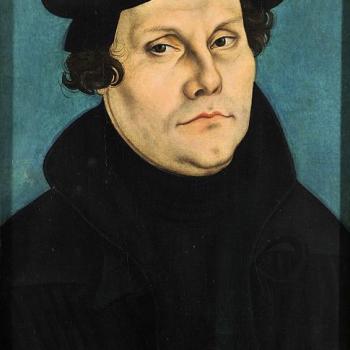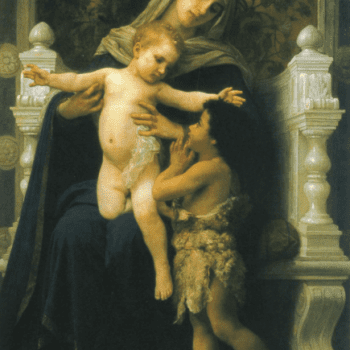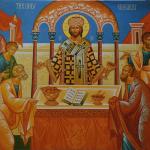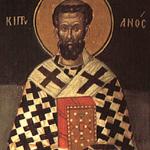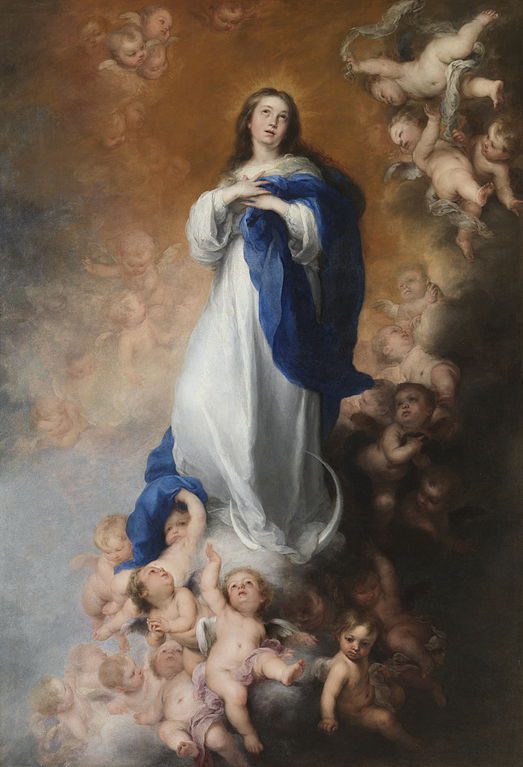
[Luther’s own words are in blue]
I have compiled more opinions from Luther scholars and other historians with regard to Luther’s acceptance of the doctrine, and particularly whether he modified his views sometime after 1527 (some think he did so).
* * * * *
[I]t is important to consider that Luther was remarkably open to some of the Marian doctrines, including Mary’s assumption, perpetual virginity and immaculate conception. While his formulation of the immaculate conception varied from the more traditional formulation, he steadfastly affirmed Mary’s complete purity. (pp. 258-259)
Luther clung also to the opinion, prevalent in the Middle Ages, that, as Mary conceived without sin, so she brought forth also without pain or physical injury, and always remained a virgin. As a bee deftly extracts the honey from a flower without injuring the latter, so the Holy Spirit caused Christ to emerge from the womb of the Virgin, because He brought with Him a true fleshly nature, but without sin. But Luther maintains most stoutly, that the Child in the womb of its mother received from her everything which any natural child receives from its mother, only without sin—that the Virgin “was required to contribute of her seed and natural blood” — that He did not pass through her like a reflection, or shadow, or as a ray of the sun passes through painted glass — that, in the act of delivery itself, the womb of Mary fulfilled its natural office (only without receiving any injury) — that a body was not made in heaven for Christ, and then passed through the body of Mary. (pp. 370-371)
3) Julius Köstlin, Life of Luther (New York: Charles Scribner’s Sons: 1883), translated from German.
The doctrine of the Immaculate Conception, which Pius IX., in our own days, first ventured to raise into a dogma of the Church, was zealously defended by the Augustinians, and firmly maintained by Luther himself, even after the beginning of his war of Reformation. (p. 45)
While Luther, Zwingli and even Calvin defended Mary’s perpetual virginity, Luther’s very traditional teaching on other key medieval Marian doctrines set him apart not only from Zwingli and the other leading proponents of the Swiss and upper German Reformations, but also from many of his own followers. Luther, for example, continued to describe Mary as sinless, though he emphasized that this state was achieved through God’s grace rather than through her own merit. [151] His exact position on the Immaculate Conception has been the subject of extensive debate. [152] Belief in Mary’s sinlessness did not necessarily imply belief in her Immaculate Conception, [153] but Luther does seem to have held that Mary had been purified from sin by the Holy Spirit at some point before Christ’s incarnation. [154] His sermon on the feast day of Mary’s conception in 1520 put him firmly on the immaculist side of the medieval controversy: Mary’s first conception was, he argued, normal but at her second conception, when the soul informed the body, she was purified from original sin. ‘So that from the first moment that she began to live, she was without all sin.’ [155] His later position wavered somewhat, and in later sermons dating from 1539 and 1540 he stated that Mary was conceived and born in sin like all men. [156] Yet he still, in 1543, felt able to write that Mary was ‘a holy virgin, who was saved and purified from Original Sin by the Holy Ghost’, although he no longer specified at what point this purification took place. [157] (pp. 58-59)[151] See especially WA, vol. 52, p. 633 (Hauspostille, 1544); Kreitzer, ‘Reforming Mary’, pp. 73-4.
[152] Dufel, Luthers Stellung, pp. 164-6; Campi, Zwingli und Maria, pp. 59-60.
[153] Kreitzer, ‘Reforming Mary’, p. 73.
[154] Ibid., p. 76.
[155] WA, vol. 17, part II, p. 288 (Festpostille, 1527); Kreitzer, ‘Reforming Mary’, pp. 241-5.
[156] WA, vol. 47, p. 860 and vol. 49, p. 173.
[157] WA, vol. 53, p. 640.
5) Beth Kreitzer, “Luther Regarding the Virgin Mary,” in Timothy J. Wengert (editor),The Pastoral Luther: Essays on Martin Luther’s Practical Theology (Grand Rapids, Michigan: Wm. B. Eerdmans Publishing Co.: 2009). Her chapter appeared originally in Lutheran Quarterly 17 (2003), 249-266.
In Luther’s final sermon on the holiday of her conception, preached in 1520, he complains that the debate about her conception has caused a great deal of trouble among the monks, even though “there is not a single letter about it in the gospels or otherwise in the Scriptures.” [41]
In this sermon Luther outlines his views on Mary’s conception and clearly leans toward the immaculist side of the debate, but takes the middle position favored by most theologians. His explanation rests on the common medieval division of generation into two conceptions: the “first conception,” that of the body, is during the act of intercourse, necessarily infected by concupiscence and thus sin; the “second conception” is at a later point when the newly formed soul enters the fetus, also called animation. . . . Mary . . . was born through the usual means of a father and a mother, and thus experienced a physical conception tainted with sin. It was at her second conception, when her soul entered her body, that she was “purified from original sin and decorated with God’s gifts.” [42] Because this second conception is more important than the first, and is the moment at which one is said to live, Luther can say that “from the first moment that she began to live, she was without all sin,” placing Mary in the “middle between Christ and other men.” [43] However, Luther insists that no required doctrine can be made about Mary’s conception, as it is not expressly mentioned in the Bible. (pp. 246-247)
[41] WA 17II:280, Festpostille (1527).
[42] WA 17II:288. The words Luther uses, “von der erbsunnde sey gerainneget worden,” clearly indicate the idea of cleansing Mary from sin rather than preserving her from it.
[43] WA 17II:288. Some scholars have doubted whether Luther maintained this belief throughout his life, and there are several ambiguous statements in later texts. He did not comment directly on the matter again.
Albert Ebneter, a Jesuit priest, also criticizes the earlier works on Luther’s views of Mary, not only for their extreme positions but also for mistakes in interpretation, for removing quotations from their contexts, and for generally twisting the evidence to support their own ends. The problems are most evident in the various presentations of Luther’s stance on the immaculate conception: the authors who tend to see Luther as devoted to Mary present his adherence to the commonly held theory, while those who find that Luther’s mind and practice changed concerning Mary present him as eventually rejecting Mary’s immaculate conception. [30] Ebneter tries to maintain a more nuanced view, by suggesting that while Luther definitely held to the immaculate conception until the early 1530s, certain statements made after that time call into question his final views on the matter. . . . Ebneter, despite his attempts to present a balanced view of Luther’s position on the immaculate conception, fails to consider the context of Luther’s statements on the queenship of Mary and insists that Luther maintained a strong Marian devotion throughout his life. (pp. 7-8)
[p. 156: footnote 30] See Ebneter [“Martin Luthers Marienbild,” Orientierung 20 (1956), 77-80, 85-87], 78-79.
Saturnin Pauleser [Catholic], in his book, Maria und die Reformation, indicates that Luther remained a devotee of Mary his entire life, at least in essentials, and even suggests that Luther continued to call Mary mediatrix. [34] (p. 8)
[p. 156: footnote 34] Saturnin Pauleser, Maria und die Reformation (Miltenberg, 1951); cited in Cole, 105-106.
Luther’s position in the 1527 Festpostille is clearly in favor if the immaculate conception . . . However, some of Luther’s later texts do call into question whether he held this position throughout the remainder of his life. In several sermons in 1532 he mentions that Mary was somehow healed from sin when she conceived through the Holy Spirit so “that she was without all sin.” [97] In a Christmas sermon from 1540, Luther stresses that Christ’s sinlessness did not simply come from the Virgin Mary’s purity [Dave: Catholics have never asserted this, since we hold that Christ was inherently sinless and indeed incapable of sin, being God] but from the working of the Spirit: Mary was “born from her parents in sin like all men.” [98] In a later writing Luther insists that Mary was “saved and purified from original sin through the Holy Spirit” at some point before Christ’s incarnation, although he does not specify when this happened. [99] These ambiguous statements do not allow for a definitive answer to the question of whether or not Luther always held to the immaculate conception of Mary, . . . (p. 124)
[three footnotes from p. 205]:
[97] Hauspostille 1544 (Christmas, 1532), WA 52, 39: “das sie ohne alle Sund gewesen ist.”
[98] Sermon on Christmas Eve, 1540, WA 49, 173: “Ideo describitue, quod natus ex virgine, nec tantum sic, quia Maria ist auch nicht zu rein, quia nata a parentibusin peccato utalii homines.”
[99] Vom Schem Hamphoras und vom Geschlecht Christi, 1543, WA 53, 640: “[Maria ist] ein heilige Jungfraw, die, von der Erbsunde erloset und gereiniget, durch den heiligen Geist.” Ebtener thinks that because this statement falls in the context of a defense of the incarnation, Luther means that Mary was purified at that point. Others (e.g., Schimmelpfennig) believe that this phrase still supports the immaculate conception. See Ebneter, “Martin Luthers Marienbild,” 78-79.
[Dave: the English translation of the key phrase from Gerhard Falk, in his book, The Jew in Christian Theology: Martin Luther’s Anti-Jewish Vom Schem Hamphoras (McFarland & Co.: 1992) is “a holy virgin . . . freed of original sin and cleansed by the Holy Ghost” (p. 217) ]
[from footnote 94 on from p. 205]:
Duns [Scotus] stresses . . . that Mary was preserved by Christ from any original sin, rather than restored to grace. Luther’s “sey gerainniget worden” may only be a manner of speaking rather than a technical explanation — it is difficult to judge, as evidenced by the number of scholars who have disagreed on Luther’s views on Mary’s conception. See, for example, Algermissen, Heiler, Schimmelpfennig, and Cole in favor of Luther holding, throughout his life, the immaculate conception of Mary; see H. Preuss and Delius in favor of Luther’s position shifting. Luther does speak of Mary as “in Erbsunden empfangen” (WA 17-2, 287) but distinguishes between the physical conception (act of the parents) and the animation by the soul, at which point the person is in existence. The reinigung of which he speaks refers, it seems, to the original sin present in the body . . . Max Thurian suggests that, when Luther speaks of Mary having original sin, he is referring both to her body before its union with her soul and to the presence of the effects of original sin in Mary’s body (fatigue, etc.). See Thurian, Mary, Mother of the Lord, Figure of the Church (London: Faith, 1963) . . .
Luther makes a number of comments about Mary’s freedom from sin, and even seems to have held to the immaculate conception, despite certain later ambiguous statements. (p. 137)
Even if one holds strictly to the doctrine of the immaculate conception, which Luther apparently did not always do . . . (p. 179)
Addendum: shortly after I compiled this paper, I became persuaded that Luther did change his later view, to a position which I describe as “immaculate purification.” Briefly, the later Luther (sometime after 1527) thought that Mary was purified at the time of the birth or conception of Jesus, rather than at her own conception.
***









